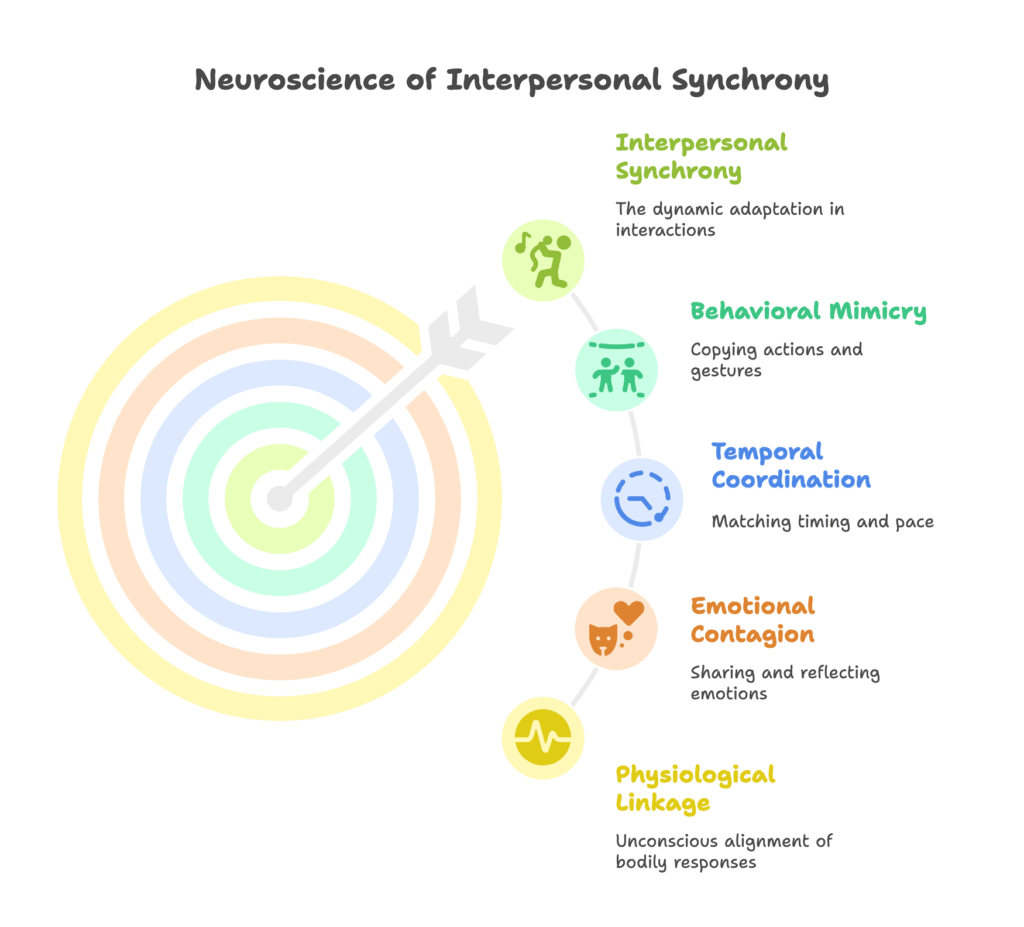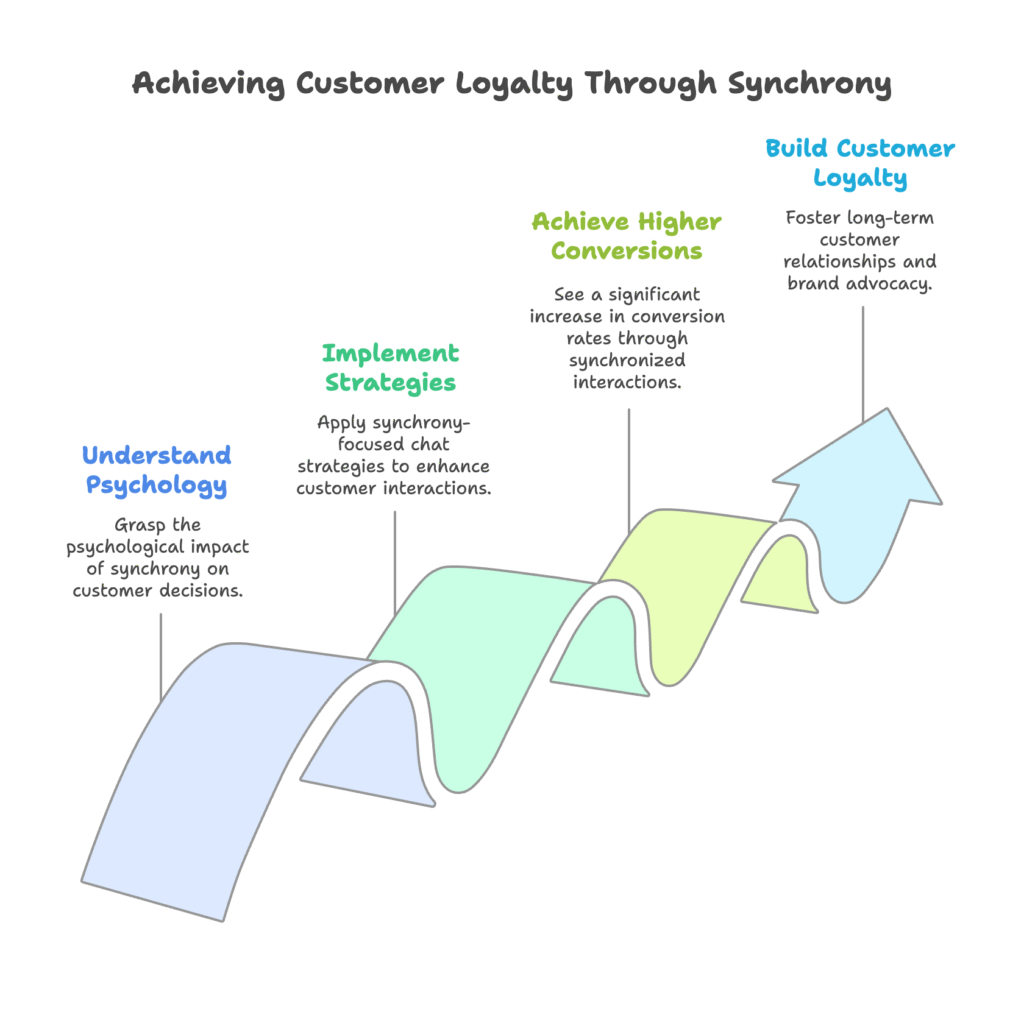Ever wondered why some sales conversations feel effortless while others fall flat? Why certain customer service chats lead to immediate purchases while similar interactions end in abandoned carts? The secret might surprise you—it’s not about what you say, but how you sync with your customers.
What if I told you there’s a scientific principle that can increase your chat conversion rates by up to 69%? That’s not marketing fluff—that’s the measurable power of interpersonal synchrony in action.
You’re about to discover the hidden psychology behind rapport-building that transforms ordinary Shopify live chat interactions into sales magnets. By the time you finish reading, you’ll understand exactly how to harness this natural human phenomenon to build deeper customer connections, boost conversions, and create memorable shopping experiences that keep customers coming back.
Ready to unlock the science of connection? Let’s dive in.
The Neuroscience of Interpersonal Synchrony
Before we jump into tactics, you need to understand what’s actually happening in your customers’ brains during those crucial chat moments. This section will reveal the fascinating science behind human connection and why some conversations just “click.”

What is Interpersonal Synchrony?
Think of synchrony as a dance. But instead of matching footsteps, you’re matching the rhythm of conversation, the flow of emotions, and even the patterns of thinking.
Scientists define interpersonal synchrony as “the dynamic and reciprocal adaptation of the temporal structure of behavior between interactive partners.” In plain English? It’s when two people naturally fall into step with each other during communication.
This isn’t just feel-good psychology—it’s measurable neuroscience. When two people achieve synchrony, their brains literally start to sync up. Brain scans show similar activity patterns emerging across both participants during synchronized interactions.
Synchrony has four core components:
- Behavioral mimicry – Copying posture, gestures, and actions
- Temporal coordination – Matching the timing and pace of responses
- Emotional contagion – Sharing and reflecting emotions
- Physiological linkage – Unconscious alignment of heart rate, breathing, and stress responses
The Brain Chemistry of Connection
Here’s where it gets interesting for your bottom line. When customers experience synchrony with your chat agents, their brains release oxytocin—the same “trust hormone” released during bonding with loved ones.
Mirror neurons activate, making customers literally feel understood at a neurological level. This isn’t manipulation—it’s tapping into fundamental human wiring that’s been helping us connect and cooperate for thousands of years.
The result? Customers don’t just hear your messages; they feel them. They stop seeing you as a salesperson and start seeing you as someone genuinely on their side.
Now that you understand the science, you’re probably wondering: “How does this translate to actual sales?” That’s exactly what we’ll explore next.
How Synchrony Transforms Customer Relationships
Understanding the neuroscience is one thing, but you want to know the real question: does interpersonal synchrony actually move the needle on your revenue? This section breaks down exactly how synchronized interactions create loyal customers and bigger sales.

The Psychology of Purchase Decisions
When customers feel synchronized with your brand, something powerful happens in their decision-making process. They start operating from a place of trust rather than skepticism.
Research shows that customers in synchronized conversations experience:
- Enhanced perception of care and attention – They feel heard and valued, not just processed
- Increased trust formation – Matched communication patterns signal reliability
- That “same wavelength” feeling – The sense that you truly understand their needs
Think about your own shopping experiences. Haven’t you bought from places where the staff just “got you”? That’s synchrony at work.
The Bottom-Line Impact
Let’s talk numbers. When Shopify stores implement synchrony-focused chat strategies, the results are dramatic:
- 69% higher conversion rates when responding within 5 minutes with synchronized communication
- 10-15% increase in cart values when chat engagement includes rapport-building techniques
- Significantly improved customer retention – synchronized customers become repeat buyers
But synchrony does more than just drive immediate sales. It creates a competitive moat around your brand.
Your Secret Competitive Advantage
In an increasingly automated marketplace, genuine human connection stands out like a lighthouse in a storm. While your competitors rely on chatbots and templated responses, you’re building real relationships.
Synchronized interactions reinforce your brand personality consistently. Customers don’t just buy your products—they buy into your brand’s way of communicating and understanding them.
And here’s the kicker: satisfied customers from synchronized interactions generate 2.3x more word-of-mouth referrals than typical transactions. They become advocates, not just customers.
Convinced that synchrony is worth pursuing? Good, because next we’re diving into the practical implementation that will transform your Shopify live chat into a conversion machine.
Implementing Synchrony in Shopify Live Chat
Theory is great, but you need actionable strategies. This section provides the concrete techniques and frameworks you can implement today to start building synchronized customer relationships through your Shopify chat system.
Setting the Technical Foundation
Before diving into conversation techniques, let’s ensure your setup supports synchrony. Your chat platform should enable:
- Real-time response capabilities – That 5-minute response window is crucial
- Agent presence indicators – Typing notifications help maintain conversational flow
- Customer context integration – Access to purchase history and browsing behavior
- Seamless handoff capabilities – For maintaining synchrony across agent changes
The interface design matters too. Agents need quick access to customer information without disrupting the conversational flow.
Mastering Rapport-Building Dialogue
Now for the conversation magic. Research identifies five key utterance types that build rapport:
Participation Appreciation
Instead of diving straight into sales, acknowledge the customer’s engagement: “Thank you for taking the time to chat with us about this.”
Strategic Self-Disclosure
Share brief, relevant personal experiences: “I actually use this product myself, and what I love about it is…” Keep it authentic and brief.
Empathetic Responses
Reflect their emotions: “I can hear how important finding the right fit is to you.” This shows you’re truly listening.
Personalized Name Usage
Use their name naturally throughout the conversation. But don’t overdo it—forced repetition feels robotic.
Appropriate Humor
Light, situational humor can break tension and build connection. But read the room—never joke about customer frustrations.
Advanced Synchrony Techniques
Ready for the advanced moves? These techniques separate good customer service from conversion-driving experiences:
Communication Style Mirroring
- Match their formality level (casual “Hey!” vs. professional “Good morning”)
- Echo key terms they use for products or concerns
- Adapt your emoji usage to match their communication style
Temporal Adaptation
- Match their response pace—urgent customers need quick replies, relaxed browsers can handle longer responses
- Calibrate message length to theirs—detailed questions deserve thorough answers
- Use typing indicators strategically to signal engagement
Emotional Contagion Management
- For frustrated customers: gradually shift tone from understanding to solution-focused optimism
- For excited customers: match their enthusiasm while guiding toward purchase
- For confused customers: maintain patient, educational energy
These techniques work, but how do you know if they’re working for your store? That’s exactly what our next section addresses—measuring and optimizing your synchrony efforts.
Measuring and Optimizing Your Synchrony Success
You can’t improve what you don’t measure. This section reveals the key metrics and optimization frameworks that will help you track synchrony effectiveness and continuously improve your chat conversions.
Key Synchrony Metrics to Track
Traditional chat metrics miss the synchrony picture. Here’s what to monitor:
Linguistic Style Matching (LSM) Scores
Measure how well agents mirror customer communication patterns. Tools can analyze transcript similarity in vocabulary, sentence structure, and formality levels.
Response Time Consistency
Track not just average response time, but consistency. Erratic timing breaks synchrony rhythm.
Sentiment Alignment Tracking
Monitor how customer sentiment evolves during synchronized vs. non-synchronized conversations.
Resolution Satisfaction Correlation
Compare customer satisfaction scores from synchronized interactions with standard service metrics.
Analytics Integration Strategy
Your analytics setup should capture the full synchrony picture:
- Chat transcript analysis – Use natural language processing to identify synchrony patterns in successful conversations
- Conversion path tracking – Follow customers from synchronized chat through purchase completion
- Customer lifetime value correlation – Track long-term value of customers who experienced synchrony
Continuous Improvement Protocol
Synchrony optimization never stops. Implement this framework:
A/B Testing Framework
- Test different rapport-building approaches
- Compare formal vs. casual mirroring strategies
- Experiment with response timing patterns
Agent Coaching Based on Data
- Identify top-performing synchrony patterns from your best agents
- Create personalized coaching plans based on individual synchrony metrics
- Role-play difficult synchrony scenarios
Customer Feedback Integration
- Include synchrony-related questions in post-chat surveys
- Analyze unsolicited feedback for synchrony mentions
- Track correlation between synchrony scores and customer reviews
Armed with these measurement tools, you’re ready to dive into Shopify-specific implementation strategies that leverage the platform’s unique capabilities.
Shopify-Specific Implementation Strategies
Shopify offers unique opportunities for synchrony that many stores overlook. This section explores platform-specific features and integrations that can supercharge your synchronized customer relationships.
Maximizing Shopify Inbox for Synchrony
Shopify Inbox isn’t just a chat tool—it’s a synchrony powerhouse when used correctly:
Collaborative Response Coordination
Multiple team members can view conversations in real-time. Use this for:
- Synchrony hand-offs between agents
- Real-time coaching from supervisors
- Specialist consultations without breaking conversational flow
Smart Conversation Categorization
Tag conversations by synchrony success and customer type. This creates a knowledge base of what works for different customer segments.
Purchase History Integration
Access to customer purchase history enables personalized synchrony. Reference past purchases naturally: “I see you loved the blue version last time—the new colors are just as stunning.”
Cross-Channel Synchrony Consistency
Your synchrony shouldn’t end with chat. Maintain consistent rapport across all touchpoints:
Unified Communication Tone
- Document your brand’s synchrony style guide
- Train all team members on consistent rapport-building approaches
- Use synchronized customer insights across email and social media
Seamless Channel Transitions
When customers move from chat to email or social, maintain the established rapport. Include synchrony notes in customer records.
Automated-to-Human Handoffs
When chatbots hand over to humans, preserve the conversational context and energy. Brief agents on the customer’s communication style before they begin.
Shopify App Integrations for Enhanced Synchrony
Leverage Shopify’s app ecosystem to support synchrony:
- Customer data platforms – Aggregate behavioral data for deeper synchrony insights
- Review management apps – Respond to reviews with the same synchronized approach
- Email marketing tools – Extend synchronized relationships into email campaigns
- Analytics platforms – Track synchrony impact across the customer journey
Implementation is crucial, but seeing real-world results builds confidence. Let’s examine how actual Shopify stores have transformed their businesses with synchrony strategies.
Real-World Success Stories
Nothing beats real examples. This section showcases three Shopify stores that implemented synchrony strategies and achieved remarkable results. Learn from their approaches and adapt their tactics to your unique business.
Fashion Retailer: 41% Conversion Lift
The Challenge: A mid-tier fashion brand struggled with high cart abandonment rates despite strong traffic from social media ads.
The Synchrony Solution:
- Style-Matching Approach: Agents analyzed customer browsing history and mirrored their style preferences in conversation. Looking at minimalist pieces? The agent adopted clean, direct communication.
- Visual Vocabulary Alignment: Agents learned to echo customer descriptions. If a customer said “flowy,” agents used “flowy” instead of “loose-fitting.”
- Decision Timing Respect: For high-consideration purchases, agents matched the customer’s deliberation pace instead of pushing for immediate decisions.
The Results: 41% increase in chat-to-purchase conversions, with customers specifically mentioning feeling “understood” in post-purchase feedback.
Health Supplement Brand: 37% Higher Average Order Value
The Challenge: Complex product line with varying customer knowledge levels led to confusion and low order values.
The Synchrony Solution:
- Knowledge Level Adaptation: Agents quickly assessed customer expertise and matched their technical language accordingly. Fitness enthusiasts got detailed nutritional breakdowns; beginners got simple benefit explanations.
- Trust-Building Through Education: Instead of immediate sales pitches, agents synchronized with customers’ learning pace, building expertise gradually.
- Health Concern Sensitivity: For customers discussing health issues, agents matched their serious, concerned tone while remaining optimistic.
The Results: 37% higher average order value and 28% increase in customer retention, with notable improvements in customer trust scores.
Tech Accessory Store: 53% Increase in Repeat Purchases
The Challenge: One-time purchases dominated sales, with little customer loyalty in a competitive market.
The Synchrony Solution:
- Enthusiasm Matching: For tech enthusiasts, agents shared genuine excitement about products. For practical buyers, they focused on functionality and value.
- Problem-Solution Synchrony: Agents mirrored customers’ problem-solving approaches—analytical customers got detailed comparisons; intuitive buyers got holistic recommendations.
- Follow-Up Synchrony: Post-purchase communication maintained the same energy and communication style established during initial chat.
The Results: 53% increase in repeat purchase rate and the highest Net Promoter Score in the company’s history.
Key Lessons from These Success Stories
- Industry Doesn’t Matter: Synchrony principles work across verticals—from fashion to supplements to tech
- Authenticity is Crucial: All successful implementations emphasized genuine connection over scripted responses
- Long-Term Focus: The biggest gains came from customer lifetime value, not just immediate conversions
- Team Training Investment: All stores invested significantly in agent training and ongoing coaching
These results are impressive, but with great power comes great responsibility. Let’s explore the ethical considerations that ensure your synchrony practices build genuine relationships rather than manipulative interactions.
Ethical Considerations in Synchrony Implementation
Synchrony is powerful—perhaps too powerful if used incorrectly. This section addresses the ethical boundaries that separate relationship-building from manipulation, ensuring your practices create genuine value for customers.
Authentic Connection vs. Calculated Manipulation
The line between building rapport and being manipulative isn’t always clear. Here’s how to stay on the right side:
The Intent Test
Ask yourself: “Am I doing this to genuinely help the customer or just to make a sale?” Synchrony should enhance the customer experience, not exploit psychological vulnerabilities.
The Natural Boundary
Excessive mirroring feels unnatural and creepy. If your agent sounds like they’re parroting the customer, you’ve gone too far. Aim for subtle alignment, not obvious mimicry.
The Transparency Standard
Customers should feel the connection is genuine. If they discovered your synchrony training, would they feel deceived or impressed by your commitment to understanding them?
Cultural Sensitivity in Global Commerce
Synchrony isn’t universal. Cultural context matters enormously:
- Communication styles vary: Direct mirroring that works in New York might offend customers from cultures that value indirect communication
- Emotional expression differs: What feels appropriately enthusiastic in one culture might seem overwhelming in another
- Relationship expectations change: Some cultures expect formal business relationships; others appreciate personal connection
Train your agents to recognize cultural cues and adapt their synchrony approaches accordingly.
Guidelines for Ethical Implementation
Set Clear Boundaries
- Limit personal information agents can share
- Establish guidelines for appropriate emotional engagement
- Create escalation protocols for customers who become too personally attached
Focus on Customer Benefit
- Prioritize customer satisfaction over conversion rates in training
- Reward agents for building long-term relationships, not just immediate sales
- Regularly audit conversations to ensure ethical standards
Maintain Human Authenticity
- Encourage agents to be themselves within synchrony frameworks
- Avoid over-scripting that makes interactions feel robotic
- Allow for natural personality variations among team members
Ethical synchrony isn’t just morally right—it’s better business. Customers can sense authenticity, and genuine connections create stronger, more profitable relationships than manipulative tactics ever could.
Now that we’ve covered implementation and ethics, what does the future hold? Our final section explores emerging trends and technologies that will shape the next generation of customer connections.
The Future of Synchrony in E-Commerce
Customer connections are evolving rapidly. This final section explores emerging technologies and trends that will shape how Shopify stores build relationships with customers in the coming years.
AI-Enhanced Synchrony
Artificial intelligence isn’t replacing human connection—it’s amplifying it:
Real-Time Synchrony Coaching
Imagine AI analyzing conversations in real-time, suggesting synchrony improvements to agents through subtle interface cues. This technology is already in beta testing.
Sentiment-Adaptive Responses
Advanced sentiment analysis will help agents recognize emotional shifts instantly, enabling more precise synchrony adjustments during conversations.
Predictive Synchrony Models
AI will predict which synchrony approaches work best for different customer types based on browsing behavior, purchase history, and communication patterns.
Omnichannel Synchrony Evolution
The future of customer relationships extends far beyond text chat:
Voice-to-Text Synchrony Maintenance
As voice shopping grows, maintaining synchrony across voice and text interactions becomes crucial. Emerging technologies are learning to translate vocal patterns into text-based conversation styles.
Video Chat Integration
Visual synchrony through video calls adds non-verbal communication layers. Expect more Shopify stores to offer video consultations with synchrony-trained specialists.
VR/AR Shopping Assistance
Virtual and augmented reality shopping experiences will require new synchrony techniques. How do you build rapport with a customer trying on virtual clothes or visualizing furniture in their space?
Personalization at Scale
The ultimate goal: creating personalized synchrony experiences for every customer without sacrificing authenticity:
- Dynamic agent matching: Automatically pairing customers with agents who have complementary communication styles
- Behavioral synchrony triggers: Systems that recognize when a customer is ready for synchronized interaction
- Cross-session memory: Maintaining synchrony context across multiple interactions over weeks or months
Preparing Your Store for the Synchrony Future
Start building the foundation for advanced synchrony now:
- Invest in data collection: Rich customer behavior data will fuel future synchrony technologies
- Train for adaptability: Teach agents principles, not just tactics, so they can evolve with new tools
- Prioritize authentic relationships: Technology will amplify your approach—make sure it’s worth amplifying
- Stay platform-agnostic: Focus on transferable synchrony skills that work across future communication channels
The future of e-commerce belongs to stores that can create genuine human connections at scale. Synchrony isn’t just a nice-to-have—it’s becoming essential for competitive survival.
As we wrap up this deep dive into interpersonal synchrony, remember: every customer interaction is an opportunity to build a relationship. The techniques you’ve learned here will help you transform those opportunities into lasting connections and sustainable growth.
Ready to transform your Shopify store’s customer interactions? While mastering synchrony can dramatically improve your chat conversions, consider complementing these relationship-building techniques with smart conversion tools. Growth Suite helps identify which visitors need that extra nudge to convert, allowing you to apply your newfound synchrony skills where they’ll have the biggest impact on your bottom line.
References
- Psychonomic Society. (2022). Buddies See, Buddies Do: Studying Synchrony in Interpersonal Relationships. https://featuredcontent.psychonomic.org/buddies-see-buddies-do-studying-synchrony-in-interpersonal-relationships/
- PsyPost. (2023). Neuroscientists Shed New Light on the Roots of Interpersonal Neural Synchrony During Social Interactions. https://www.psypost.org/neuroscientists-shed-new-light-on-the-roots-of-interpersonal-neural-synchrony-during-social-interactions/
- Kafkas, A., & Montaldi, D. (2023). Classifying Interpersonal Synchronization States Using a Data-Driven Approach. Nature. https://www.nature.com/articles/s41598-023-37316-5
- Bowsher-Murray, et al. (2022). The Components of Interpersonal Synchrony in the Typical Development. Frontiers in Psychology. https://www.frontiersin.org/journals/psychology/articles/10.3389/fpsyg.2022.897015/pdf
- Monitask. (2024). What Is Interpersonal Synchrony? https://www.monitask.com/en/business-glossary/interpersonal-synchrony
- Baihaqi et al. (2024). Rapport Building Dialogue Strategy for Improving User Experience. ISCA Archive. https://www.isca-archive.org/interspeech_2024/baihaqi24_interspeech.pdf
- ACOWebs. (2024). How To Transform Your eCommerce Strategy with Neuromarketing. https://acowebs.com/neuromarketing-in-ecommerce/
- Psychology Today. (2020). What is Synchrony and Why is it Important? https://www.psychologytoday.com/us/blog/the-biology-bonding/202006/what-is-synchrony-and-why-is-it-important




